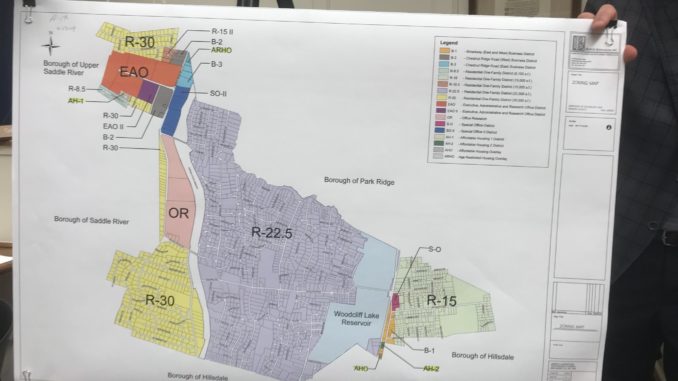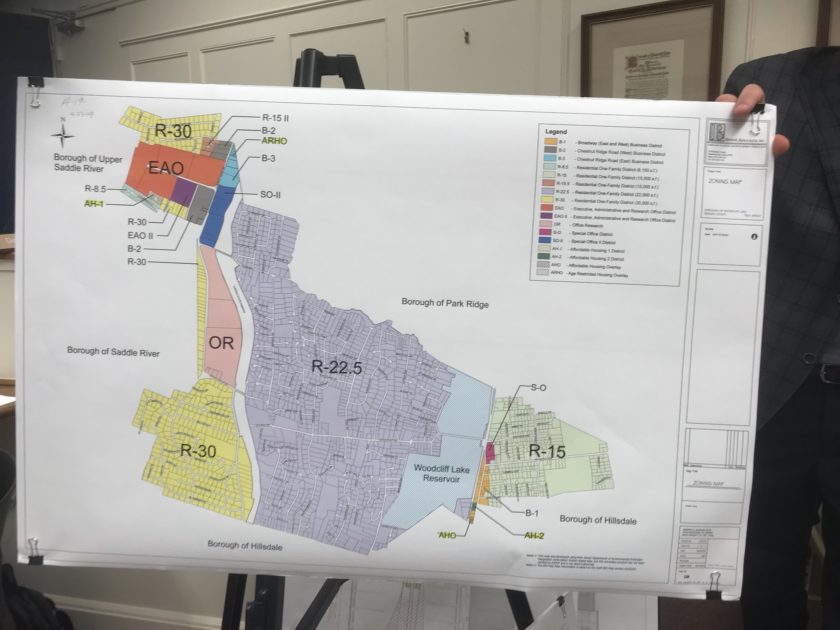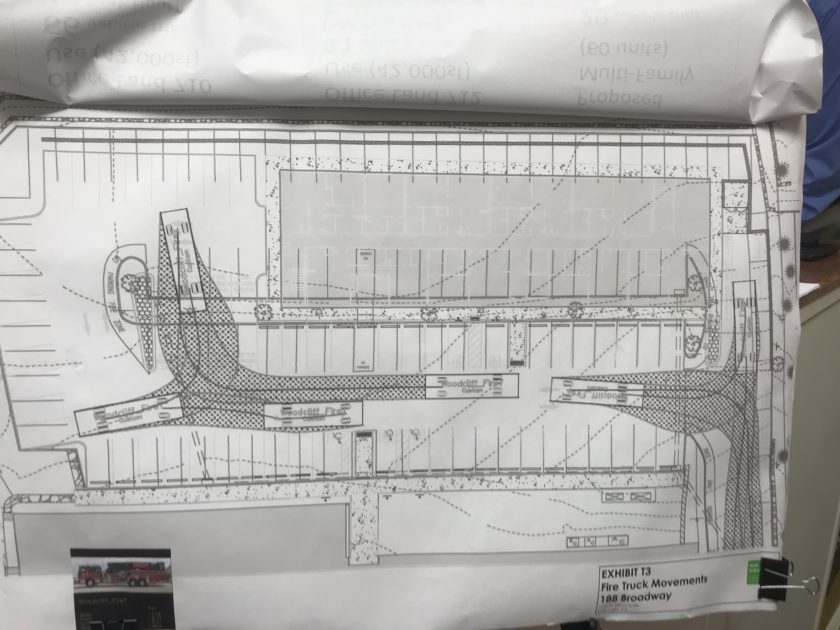
WOODCLIFF LAKE, N.J.—An applicant planner for a 60-unit multifamily complex at 188 Broadway spent nearly an hour April 23 listing more than a dozen “positive criteria” and “special reasons” that Zoning Board of Adjustment members should consider when voting on its proposal, which is opposed by a local citizens group who view the complex as high-density “overdevelopment” of the Broadway Corridor.
The next hearing is June 4 at 7 p.m., said Chair Christine Hembree. A vote is a possibility. The session will be the sixth hearing and conclude planner testimony, plus brief testimony from the traffic engineer.
Due to a prior application April 23, the hearing did not commence until almost 9 p.m.
The meeting also featured testimony from two Woodcliff Lake Volunteer Fire Department officials, who noted they were “comfortable” in fighting a fire at the proposed complex, despite residents’ efforts to cast doubt on the ability for fire engines and apparatus to access the site.
Over an hour, planner Joseph A. Burgis, of Burgis Associates Inc., Westwood, reviewed the proposal by 188 Broadway LLC and pointed out how the proposal satisfies local code and planning documents including the 2002 Master Plan, the borough’s last completed plan, a 2008 Master Plan reexamination, and a 2008 Broadway Corridor study.
Burgis said the proposed plan provides nine affordable housing units (15 percent of 60 rental units), provides 111 parking spaces that meets state-mandated Residential Site Improvement Standards for parking, and accounts for 42 percent impervious coverage, where borough code allows up to 60 percent.
He said the proposal complements five Master Plan goals, including placing multifamily housing in a non-residential zone; placing development near transit or a train station; providing adequate light, air and open space; ensure development preserves natural features (i.e. steep slopes); and improving Broadway business district and connection to train station.
Development ‘sound planning’
“In many respects, by placing multifamily development near that train station and near other planned commercial development contemplated in the area it represents sound planning for the municipality,” said Burgis.
He said the development “was consistent” with State Plan Smart Growth, borough Broadway Corridor study, and multifamily development near a train station to encourage mass transit use.
Burgis said the 2008 Broadway Corridor Study “recognizes that the (corridor) has the potential to accommodate to changing market conditions.” He said the office building on site, built in 1981, was constructed before computers came into widespread use.
He said the study “recognizes the demand for multifamily development” in the area as population ages and residents “need to find something they can downsize into” near a familiar neighborhood by friends and family.

Affordable ‘unmet need’
Burgis said the borough has “an unmet need” of 439 affordable housing units between now and 2025 and “we’re assisting you in achieving that unmet portion of your (affordable) need” by providing nine affordable units in the 60-unit complex.
He said while unmet need “may be more of an aspirational goal” by adding nine affordable units “you will get a leg up” with the unmet need.
The borough’s affordable housing settlement was approved in November 2017.
Burgis said because the site’s zoning does not permit multifamily housing, the applicant is requesting a D-1 use variance, and also a height variance for a second building on the site proposed at three stories in height, not 2.5 stories as permitted by borough code.
Burgis went through a listing of positive criteria and negative criteria, with positive attributes or “special reasons” being highlighted.
He said “special reasons” to approve the application include the proposal “furthers a number of purposes of the state’s Municipal Land Use Law” including to encourage municipal action for appropriate land use such as placing multifamily housing near a train station.
Other special reasons cited were encouraging light, air and open space, promoting an appropriate population density (proposed at 16.9 units per acre), which Burgis presented in a chart comparing densities at specific local multi-unit developments.
Burgis highlighted specific land-use zones for housing density (i.e. units per acre) including affordable zones, an age-restricted development. The chart, titled “Comparison Proposed Development to Woodcliff Lake Multiple Dwelling Zones” compared the proposed 16.9 units per acre density proposed at 188 Broadway to six other multi-dwelling land uses.

Density ‘in the middle’
“Our 16.94 [units per acre] is smack dab in the middle of the ranges of density that are identified in our multi-dwelling zones,” he said. “it is clear that the municipality has made a determination that our proposed 16.94 fits well within your range from a low of 12 to a high of 20 per acre,” said Burgis. He said he was responding to a board request to provide unit density at other multi-dwelling buildings in town.
Another “special reason” cited by Burgis is “furthering the principles of Smart Growth… encouraging mixed land-uses and multifamily developments along the Broadway Corridor,” said Burgis.
He said other Smart Growth principles included a walkable neighborhood, and compact building design.
Another reason to approve the development includes less traffic generation from residential versus an office use, previously presented by applicant’s traffic engineer, said Burgis.
Fire department addresses concerns
Deputy Fire Chief George Fusco said after meeting with the applicant and reviewing the applicant’s revised site drawings the department wrote an April 1 letter stating it had “no issues or concerns” with the access to the site or fire apparatus movement on site.
He said the fire department met with the applicant after having issues with access “but after meeting with the applicant we worked everything out to our satisfaction to make it easier for us to get in and get out,” Fusco said.
He said the department has been responding to the building site for over 30 years, and the only proposed change is an additional building on site.
“The biggest thing was to work out, us being able to make sure, the in we’ll get there, but make it a little easier for us to get out because before we worked with the applicant they were narrowing the area down. They opened it up and opened up additional area to make it easier for us,” to maneuver, said Fusco.
Fusco said “the less backing we do is always better” when maneuvering fire apparatus but said the site’s layout provides enough space to enter and leave even if all visitor spots are filled with cars. He said if parked cars block turning radius, the fire apparatus will back out.
Fusco was asked about a fire breaking out on the east side of the complex, and what happens if a truck cannot access the fire site.
“Just cause our trucks can’t get there doesn’t mean we can’t get there,” said Fusco.

He said he felt confident that the fire suppression system being required at 188 Broadway would keep a fire in check until local firefighters arrived on scene and felt confident that the fire department could handle any fire in the buildings.
Under resident questioning, Fusco said an evacuation plan “is done after the fact, a lot of that is also followed up thorough fire prevention…until it’s built you don’t know,” said Fusco.
He said that while the complex is being built, the fire department will inspect it and provide feedback on fire safety concerns.
‘Feel comfortable with plans’
“From what we see on these plans, we feel comfortable extinguishing a fire on this property,” said Schuster. Fusco said “all of our conditions, everything we’ve questioned has been met” by the applicant.
Fusco told Veronica Appelle that he could not answer her hypothetical question about what might they do if a “perfect storm” hit of severe weather, major fire on the east side, and a train stopped at the station.
“We can envision it, yes, but we can’t answer ‘what if’ questions. We prepare for everything,” said Fusco. Fusco said local equipment supplemented by fire departments’ mutual aid should be adequate to fight any fire.
Fusco said access to fire hydrants and standpipes is most important when responding to a fire on the site.

Parking not a concern
“Full parking capacity does not affect the number of fire trucks I can get in here. All these spots can be full or empty I can still get the same number of fire trucks in this lane,” said Fusco. He said other emergency vehicles can fit behind a large fire truck that enters the site first.
Fusco and Schuster both said they’ve been on thousands of fire calls over their volunteer firefighting careers. Fusco has served 33 years as a local firefighter and Schuster has served 19 years.
Member John Spirig said both Fusco and Schuster “only care about two things: doing the right thing for residents and doing the right thing for firefighters.”
He added, “I for one am confident in their recommendations.”
